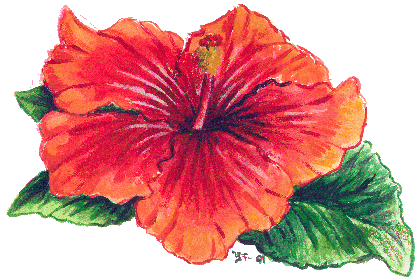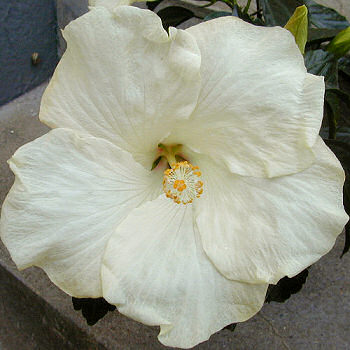
 |

Hibiscus like the conditions that appeal to people thus these tropical plants are well suited to be grown indoors. Growing hibiscus in pots is not too difficult if you follow a few simple rules. Potted hibiscus can become very old, forty years or more is not that rare. Below is a short course in indoor hibiscus care. These tips are most suitable for people in Northern regions but can be applied elsewhere where indoor culture is necessary. | |
 | PlacingHibiscus are tropical plants that need light and, perhaps more importantly, warmth to thrive. They prefer moderate heat and to continue blooming must have a few hours of direct sunshine every day. Place your plant in a bright South or West facing window. An Eastern window might also work. In winter watch out for cold drafts that can give hibiscus frostbite. In the winter you also need additional light. I use simple fluorescent bulbs, often referred to as low energy light, which screw into regular sockets. For best effect, place the light as close to the plant as possible. In summer it is wise to protect the roots from excessive heat by using planters. |
WateringHibiscus like water but do not let it stand with 'wet feet'. The soil needs to dry up between waterings to protect from root rot. Make certain no excess water remains in the planter half an hour after watering. Pay particularly attention to this for plants that are placed in a cool spot where the temperature stays below 60F (+16C). It's important to refrain from watering with cold water in winter. I always give warm water, 95-102F (+36-40C), during the colder months. Feel with the hand that the water doesn't get too hot. Fertilizing | |
For prolific flowering, hibiscus must have regular feedings every week during the growth period, March-October. Water soluble formulas can be used with every watering. I usually water 9 times with fertilizer and then flush with clean water the tenth time. This will prevent salt buildup in the pot. Never fertilize dried out plants -you may damage the roots. First rehydrate the soil by putting the pot in a bucket with about 2" (5 cm) of water. Add a dash of regular dish detergent to break water tension, this will allow the water to better penetrate the dried out soil. Leave pot for 30 minutes in bucket then return to planter. When the soil is once again moist through you may fertilize. |
 |
SoilHibiscus want loamy but not too heavy soil. Regular quality potting soil with added [leaf]compost is an ideal base. Personally I mix my own of 1/3 coarse peat, 1/3 composted bark and 1/3 composted [cow] manure mixed with leca and vermiculite. Leca, sand or other filler should not make up more than 10% of the finished mix. The soil should be coarse rather than fine. Watch out for soil that is mainly fine peat, it tends to compact in the pots, resulting in badly aerated roots. | |
 | ReplantingHibiscus have good root systems. Healthy roots are white to tan in color, crisp and plump. Replanting is usually carried out in spring, February-March. Often you can at that time observe roots poking out of the bottom of the pot through the drainage holes. When the root ball has been carefully loosened and lifted out of the pot, it can at times be seen that the roots are wrapt around the inside of the pot. These roots must be loosened up properly and perhaps shortened. Completely cut away any dark brown and soft roots. I doesn't matter if some of the roots break off. A root pruning might have to be carried out if there is too much roots. Replant in a one size larger pot than before. |
PruningThe best time for pruning hibiscus is August-October, but some practice spring pruning with good results. Pruning is carried out not only to get a more harmonious plant but also to stimulate budding as hibiscus flower on new shoots. To create a good looking plant, try to establish 3-4 main branches. These should be sturdy and upright. Cut back 1/3 of the main branches and completely remove weak growth or sideways growing branches. You might decide to root prune at the time of replanting. Never prune off more than 1/3 of the root mass. It is better to err on the careful side here. Pests | |